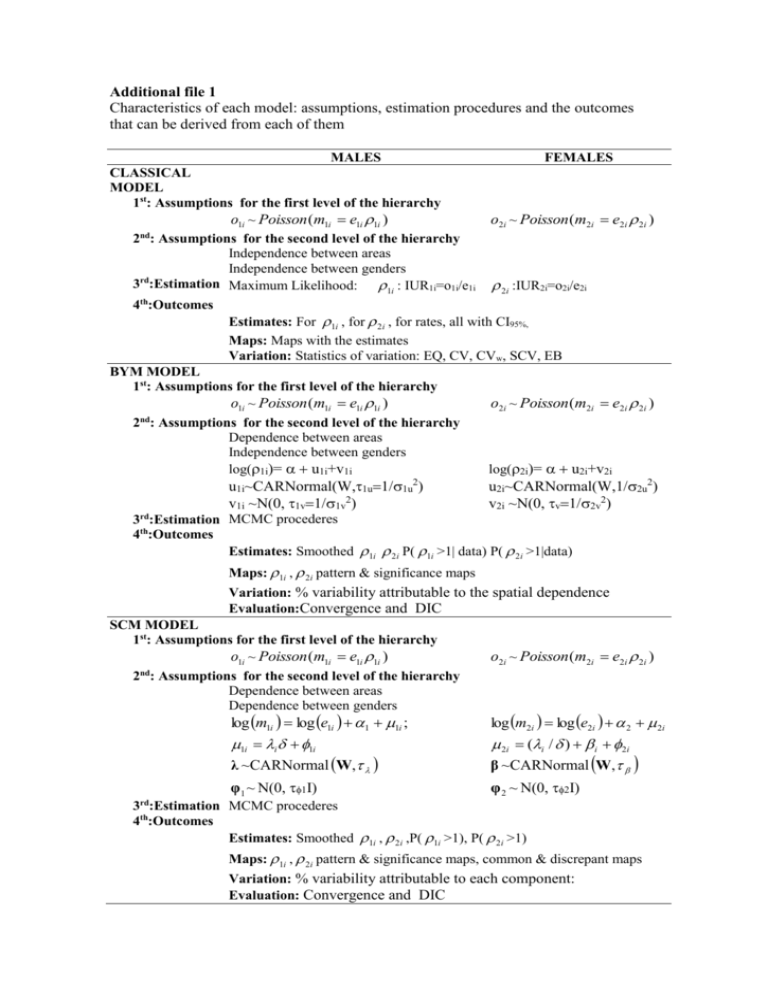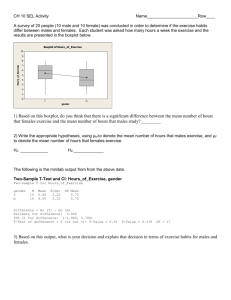Additional file 1
advertisement

Additional file 1 Characteristics of each model: assumptions, estimation procedures and the outcomes that can be derived from each of them MALES FEMALES CLASSICAL MODEL 1st: Assumptions for the first level of the hierarchy o1i ~ Poisson (m1i e1i 1i ) o2i ~ Poisson (m2i e2i 2i ) nd 2 : Assumptions for the second level of the hierarchy Independence between areas Independence between genders 3rd:Estimation Maximum Likelihood: 1i : IUR1i=o1i/e1i 2i :IUR2i=o2i/e2i 4th:Outcomes Estimates: For 1i , for 2i , for rates, all with CI95%, Maps: Maps with the estimates Variation: Statistics of variation: EQ, CV, CVw, SCV, EB BYM MODEL 1st: Assumptions for the first level of the hierarchy o1i ~ Poisson (m1i e1i 1i ) o2i ~ Poisson (m2i e2i 2i ) nd 2 : Assumptions for the second level of the hierarchy Dependence between areas Independence between genders log(1i)= u1i+v1i log(2i)= u2i+v2i u1i~CARNormal(W,1u1u2) v1i ~N(0, 1v1v2) u2i~CARNormal(W,2u2) v2i ~N(0, v2v2) 3rd:Estimation MCMC procederes 4th:Outcomes Estimates: Smoothed 1i 2i P( 1i >1| data) P( 2i >1|data) Maps: 1i , 2i pattern & significance maps Variation: % variability attributable to the spatial dependence Evaluation:Convergence and DIC SCM MODEL 1st: Assumptions for the first level of the hierarchy o1i ~ Poisson (m1i e1i 1i ) nd 2 : Assumptions for the second level of the hierarchy Dependence between areas Dependence between genders o2i ~ Poisson (m2i e2i 2i ) log m1i log e1i 1 1i ; log m2i log e2i 2 2i 1i i 1i λ ~CARNormal W, 2i (i / ) i 2i β ~CARNormal W, φ1 ~N(0, φ 2 ~N(0, rd 3 :Estimation MCMC procederes 4th:Outcomes Estimates: Smoothed 1i , 2i ,P( 1i >1), P( 2i >1) Maps: 1i , 2i pattern & significance maps, common & discrepant maps Variation: % variability attributable to each component: Evaluation: Convergence and DIC * Notation used in previous table Specification Common notation o1i , o2i e1i , e2i 1i , 2i Classic model IUR1i, IUR2i EQ, CV, CVw, SCV, EB BYM model u1i, u2i v1i,, v2i % variance spatially structured P( 1i >1| data) P( 2i >1| data) DIC Explanation Number of admissions in area i in males and in females Number of expected admissions in area i in males and in females, assuming common rates along the whole region Risk of admissions in males and females in area i, unknown, needs to be estimated Indirect Utilization ratios, which are the estimates for 1i , 2i via Maximum-Likelihood IUR1i=o1i/e1i Statistics of Variation EQ: Extremal Quotient; CV: Coefficient of Variation; CVw: Weighted Coefficient of Variation; SCV: Systematic Component of Variation; EB: Empirical Bayes statistic. Higher values indicate higher variability. Random effects which model the spatial correlation in the risk of admission for males (u1i) and females (u2i). To do so, a conditional autorregresive distribution is assigned for each one, CARNormal(W,1u1u2). If data are not correlated, the variance component estimate, 1u, will be low Random effects which have independent structure, N(0, 1v1v2). They need to be included together with the ui random vector, otherwise we would be forcing spatial structure where it may not be present. =sum2/ (sum2 + v2), where sum2 is the marginal spatial variance, sum2=∑i(ui ū)2/(n-1), The posterior probability for area i to have an admission risk higher than that for the whole region, given the data. These values are often used to derive probability maps, for which cut-off points 0.2 and 0.8 are used. Deviance Information Criteria: it is used in the Bayesian framework to compare models. DIC=D+ pD, where D is the Deviance average and pD the number of effective parameters. Models with smaller DIC are preferred. SCM model 1i , 2i i i , 1i , 2i In the log-scale, the relative risk of admission in area i for males and females compared to that of the whole region The random effect assigned to area i, which represents the shared risk in males and females. We assumed it as spatially correlated. A parameter that allows for a different gradient on the shared component for males and females. The random effects assigned to area i, which depict differences between males and females with respect to the common pattern. 1i is referred to males and i and 2i are referred to females, i with spatial structure and 1i and 2i with an independent structure. Partition of variance P( 1i >1| data), DIC The whole variability observed in males can be decomposed by that attributed to the common pattern and that specific to males. The same applies to females. Idem explanation as for BYM model








